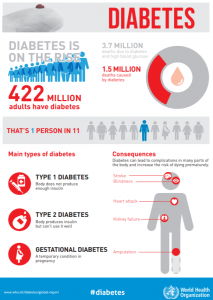- Understanding Diabetes is that it is a chronic (long-lasting) health condition that affects how the body turns food into energy.
- Most of the food you eat is broken down into sugar (also called glucose) and released into your bloodstream.
- When your blood sugar goes up, it signals your pancreas to release insulin. (3)
DATA ANALYSIS.
- The number of people with diabetes rose from 108 million in 1980 to 422 million in 2014.
- The global prevalence of diabetes* among adults over 18 years of age rose from 4.7% in 1980 to 8.5% in 2014 (1).
- Between 2000 and 2016 there was a 5% increase in premature mortality from diabetes. (2)

UNDERSTANDING TYPE 1
- In this what we need to learn about type 1 diabetes. The CDC estimates that nearly 1.6 million US resident has it, including about 187,000 children and adults. (1)
- In type 1 diabetes, the body do not manufacturers insulin. (1)
- The body breaks down the carbs we eat into blood sugar that it uses in the form of energy and insulin is a hormone that the body needs to get glucose from the bloodstream into the cells of the body. (1)
- With the help of insulin therapy and other treatments, everyone can learn to manage their condition. (1)
UNDERSTANDING TYPE 2
- Type 2 diabetes is the most common form of diabetes in this our body doesn’t use insulin properly. (1)
- while some people can control their blood sugar levels with healthy food habits and regular workout, some may need medication or insulin to help manage it. (1)
UNDERSTANDING GESTATIONAL DIABETES.
- Its another newly emerging kind of diabetes which doesn’t have much awareness cause, but we know that you are not alone. It happens to a large number of women. (1)
- We know that the placenta supports the baby for its proper growth and development.
- Sometimes, these hormones also block the action of the mother’s insulin to her body and this leads to causes a problem called insulin resistance. (1)
- This insulin resistance makes it tough for the mother’s body to use insulin. And this means that she may need up to three times as much insulin to compensate. (1)
UNDERSTANDING DIABETES FROM OTHER CAUSES
- In addition to type 1, type 2 and gestational diabetes, a small minority of people develop specific types of diabetes due to other causes. This includes:
- Monogenic diabetes syndromes, such as neonatal diabetes and maturity-onset diabetes of the young (MODY).
- Diseases of the exocrine pancreas, such as cystic fibrosis and pancreatitis.
- Drug- or chemical induced diabetes, such as with glucocorticoid use, in the treatment of HIV/AIDS or after organ transplantation. (1)
UNDERSTANDING PREDIABETES
- The prediabetes condition does not have clear symptoms so we may have it and stayed unaware of this. (1)
- That’s why it’s important to know before people develop type 2 diabetes, they almost always have prediabetes symptoms blood sugar levels that are higher than normal but not yet high enough to be diagnosed as diabetes. (1)
DIAGNOSIS AND TREATMENT
- Early diagnosis can be done through a relatively inexpensive blood sugar level test.
- Diabetes treatment majorly focuses on diet and physical work along with maintaining of blood glucose and the levels of other known risk factors that cause damage to blood vessels. Tobacco consumption is also important to avoid complications.
- Interventions that are both cost-saving and feasible in low- and middle-income countries include:
- blood glucose control, particularly in type 1 diabetes. People with type 1 diabetes require insulin, people with type 2 diabetes can be treated with oral medication, but may also require insulin.
- The Jeopardize – High or Low Blood Pressure.
- Foot care, patient self-care by maintaining foot hygiene; wearing appropriate footwear; seeking professional care for ulcer management; and regular examination of feet by health professionals. (2)
REFERENCE.
